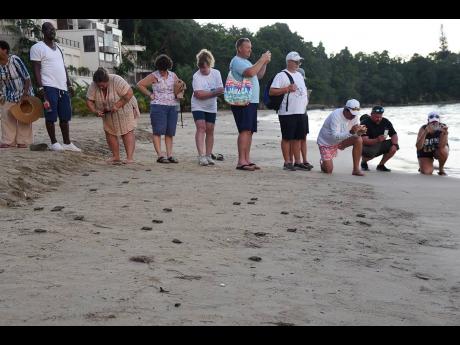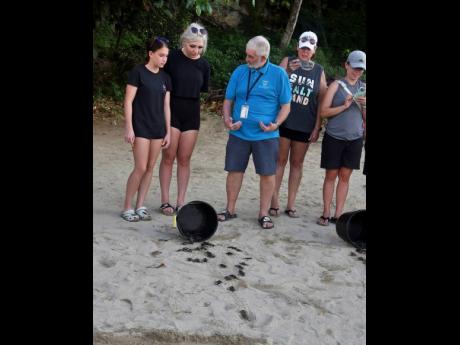Turtles under threat
Conservationists seek first aid for injured turtles; caution animal owners about attacks
SEA TURTLES that play a vital role in the ocean ecosystem are under threat across several shores in Jamaica.
The animals help to maintain the health of coral reefs and sea grass beds, and also contribute to the transportation of essential nutrients from the oceans to seashore.
However, the varying species are critically endangered as both wild and domestic dogs are threatening their survival.
The National Environment and Planning Agency (NEPA) reported last month that dogs have been attacking sea turtles, uprooting nests, and maim and eat turtle eggs and hatchlings.
They further stated that despite several joint efforts between the agency, non-governmental agencies and concerned citizens, dogs continue to be a nuisance to the turtle population and in some extreme cases, they have killed adult sea turtles.
Some affected locations include along the Queens Highway in Discovery Bay, St Ann; Treasure Beach, Billy’s Bay, Frenchman’s Bay, Calabash Bay, and Fort Charles in St Elizabeth; and Frenchman’s Cove and San San Beach in Portland.
NEPA continued that the issue was experienced more severely in areas where there are larger populations of dogs, such as near tourist resorts and fishing villages.
They have warned dog owners that they could find themselves in trouble with the law if their pet attacks the turtles.
HATCHLING RELEASE
Last Thursday The Gleaner visited Melyvn ‘Turtleman’ Tennant, founder of the Oracabessa Bay sea turtle project at Gibraltar Beach in Oracabessa, St Mary, where he conducted a hatchling release exercise with a group of tourists to the island.
Speaking to the Hawksbill turtles ( Eretmochelys imbricata) which are the main species in Jamaica, Tennant noted that since the start of the year, there have been nearly 300 incidents involving turtles and over 15,641 hatchlings released from over 155 nests.
In relation to the dog attack on turtles, Tennant said that pet owners needed to take more responsibility in ensuring that they contain animals in their yard and if they take them out, to put them on a leash.
He said that there needed to be public education activities for people to know that if they let their dog run wild and it did damage to a wild animal, they could be fined or imprisoned, adding that enforcement of these same laws needed to be increased.
Tennant noted three attacks on nests, out of 185, on Gibraltar Beach and four cases associated with wild dogs in Priory, St Ann.
He informed The Gleaner that he is looking to work with Tuft’s University in Boston, the Massachusetts Institute of Technology and the New England Aquarium to produce a first-aid kit for the turtles.
“The number of vets in Jamaica that know how to treat the wounds is limited. In fact, it’s almost non-existent,” he said.
Within the next year, Tennant’s intention is to set up a first-aid kit programme and to get them to the beaches where turtles are affected, and engage with veterinarians in basic training on how to save the turtle’s life under such circumstances.
“You can take them (the turtles) to the marine places like Discovery Bay or down at Port Royal because they don’t have the facilities to look after them in the first place but secondly, [to] keep them because you need recuperation tanks if they’re badly damaged,” he said.
SEXUAL MATURITY
The turtles take decades to reach sexual maturity – between 20 and 30 years – and, on average, will lay 110 eggs in a nest, in an average of between two and eight nests per season (March 1 to October 31).
The same individual turtle does not nest every year, but rather every two to five years and it is estimated that only one in 1,000 hatchlings survive to maturity, making the loss of a nesting female extremely devastating.
Belinda Collier-Morrow, co-chair of White River Fish Sanctuary in St Ann which monitors up to four beaches in the parish, told The Gleaner that they did not have issues with the animals attacking the turtles in the area but that they were digging up the nests, especially near the river.
“There’s a whole pack of dogs that hang around there at night, but where there have been some problems are random beaches along the coast,” she said.
“If a turtle is attacked, chances are it’s not going to survive ... the dog is going to attack its leg, flipper or head and the turtle is going to die,” she said of the impact of this kind of activity.
Sea turtles are protected animals under The Wild Life Protection Act (WLPA) 1972.
The agency stated that the “owner of an animal” according to section 2 of The Keeping of Animals Act 1979 “means the owner in possession or person in charge of any animal”.
Section 7 of the act provides that “whosoever shall allow – (a) any prohibited animal to be at large within a prohibited area; or (b) any prescribed animal to be at large within a restricted area, shall be guilty of an offence and liable on summary conviction”.
NEPA continued that section 5 of the Cruelty to Animals Act 1960 stipulates that “every person who, by wilful negligence, causes any injury, suffering to any animal, shall be guilty of an offence against the act”.
Additionally, Section 16 of the act allows for the owner of the offending animal to make additional payments for veterinary treatment, and the court may direct that the animal that committed the offence be slaughtered in “a manner as to inflict as little pain and suffering as practicable”.
CULTURE SHIFT
Collier-Morrow called for a culture shift in how pet owners take care of their dogs by ensuring that they are properly caged away and not roaming the streets freely to attack other animals or humans.
She welcomed Tennant’s initiative and spoke to the importance of consistent workshops directed to stakeholders and communities.
Tennant has been working in the field since 2003. He said meaningful community engagement and education was key in helping to limit the threats to the turtles caused by humans.
In past times, the turtle eggs would have been dug up and taken to make ‘turtle punch’ as individuals believed the eggs to have aphrodisiac properties.
“We’ve now stopped that completely. We haven’t lost a nest in 13 years ... we’re basically in a situation now where nobody touches turtles,” he said.
“Nature is a wonderful thing but we’re not looking after it ... if we take care of the wildlife, so much of the good things will remain,” Tennant added.
Methods to reduce threat posed to nesting sea turtles:
- Ensure that proper signs are erected in areas where sea turtles and nesting are common;
- Keep dogs on a leash when they are near beaches;
- Ensure that the population is aware of the offences under the WLPA, Cruelty to Animals Act, and the Keeping of Animals Act;
- Ensuring that dogs are not permitted in the vicinity of areas that sea turtles occupy during nesting and hatching periods;
- Spraying or neutering dogs to reduce the number of stray dogs in Jamaica;
- Support organisations that are working to protect sea turtles by volunteering and making donations to assist with the monitoring of nesting and hatching sites;
- And volunteer for participation in NEPA’s sea turtle monitoring exercises




